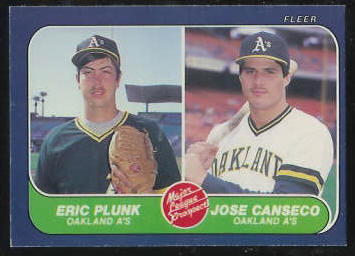Jose Canseco - 1986 Fleer #649 ROOKIE (A's)


Please wander around the website for more info, prices, values & images
on vintage baseball, football, basketball, hockey, sport and non-sports cards.
1974 Topps & Parker Brothers FootballIn 1974, along with cards in wax packs, Topps also issued the football cards used in Parker Brothers' "Pro Draft" board game. The (50) Parker Brothers cards are skip numbered from the 1st 132 Topps cards and are all offensive players, mostly from the skill positions.Most Parker Brothers cards are similar to the ones from packs except on the back where most Parker Brothers cards had 1972 stats instead of 1973 and (2)* rather than (1)* in the copyright line. BUT NOTE: Some regular Topps cards have both * and ** --- It's complicated! Six of the cards have totally different designs; three All-Pros and three with horizontal designs that were changed to vertical to match the rest of the cards.
Team checklist cards were randomly included in the Topps wax packs.
Click for complete
1974 Topps & Parker Brothers Football checklist and prices
|

1933 Goudey Baseball Cards |

1972 Topps AUTOGRAPHED |

Cabinet Card Were oversized trading cards featuring paintings issued mostly 1910-1915.
Card Show is a gathering of dealers & collectors looking to buy/sell/trade sports cards and memorabilia.
Card Stock is the material a card is printed on. Usually paper-based, today companies play with the card stock and sometimes it appears to be wood or leather or see-thru acrylic ...
Cello Pack is a card pack whose wrapper is see-thru plastic. Usually the top & bottom cards are seen. Unopened cello packs showing major stars and rookies sell for heavy premiums.
Centering is the balance of the borders: top/bottom & left/right. On perfectly-centered cards, top/bottom borders match as do the left/right borders. Centering is presented as a set of numbers & directions and often included with the grade. Perfectly-centered is "50/50 t/b" AND "50/50 l/r". As centering gets worse, one number increases and the other decreases. For example: 90/10 t/b is considered extremely off-center top to bottom. The numbers add up to 100 (50/50, 60/40, 90/10 ...).
Certificate Of Authenticity (COA) A document used to verify legitimacy of a collectible. NOTE: Keep in mind that COA's are easier to fake then autographs.
Common A card of a non-star player is considered a "Common" as opposed to cards of a star players or specialty/subset cards such as league leaders, teams cards, World Series cards...
Condition (Grade) Centering, corner wear, photo clarity, edges, creases, print flaws ... all combine to determine a card's condition or grade. Along with rarity/scarcity it is the major factor in a card's value.
Crease Defect usually caused by bending the card. Hard to see, or not, a crease lowers the card's grade (VG or lower) and greatly diminishes it's value.
